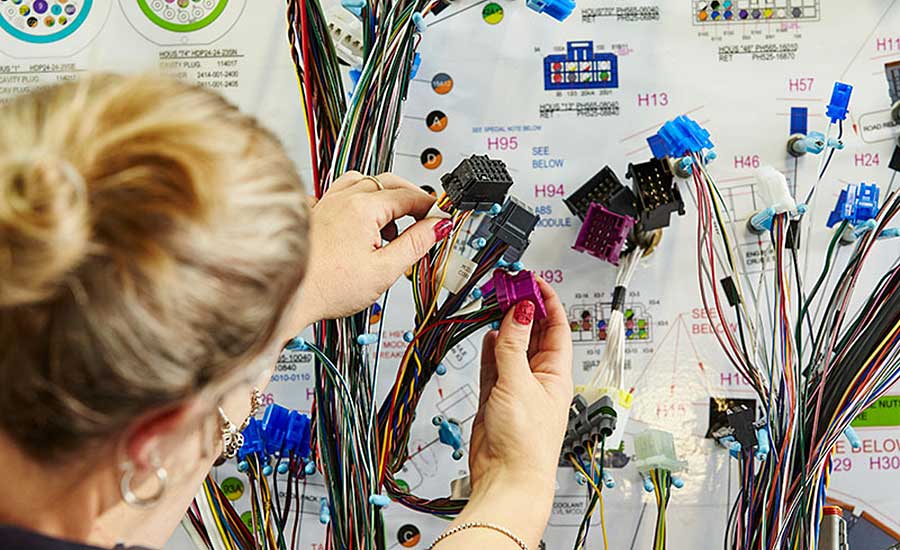The Ergonomics of Wire Harness Assembly
Manual tasks pose numerous risks to assemblers






When it comes to assembling wire harnesses, humans still do it better than automation. That’s why wire processing remains a largely manual process. However, it also poses a number of ergonomic issues and concerns, including the risk of back, finger, neck, shoulder and wrist injuries.
Assemblers bend and reach to run wire from pin to pin. They use hand tools to cut, crimp, strip, tie and tape wires. Assemblers also insert wires into connectors and terminals. To prevent repetitive stress injuries, engineers must pay close attention to ergonomics.
Carpel tunnel and tendonitis are two of the more common repetitive motion injuries associated with wire processing. On final assembly lines, inserting harnesses into appliances, boats, buses, cars, planes, trains, tractors, trucks and other products also presents numerous ergonomic challenges.
“Wiring harness assembly is a big pain in the neck,” says Cindy Roth, CEO of Ergonomic Technologies Corp., a consulting firm that has worked with manufacturers in a variety of industries. “It’s lousy for any type of ergonomic interventions.
“The body parts at the highest risk of injury are calves, hands, necks and shoulders,” notes Roth. “Poor postures are common. That’s because most assemblers stand, bend over at their necks and hunch their shoulders. Hands also have to perform a lot of repetitive tasks that require forceful movements.”
“Wire harness assembly is very hand intensive,” adds Julia Abate, executive director of the Ergonomic Center of North Carolina. “Anytime you’re doing any manual tasks that are repetitive, such as wire cutting, stripping, crimping or wrapping, there’s a greater risk for injury. Holding wires or fitting wires into connectors requires a lot of two-finger and lateral pinches, which can cause problems.
“Seated work is OK, as long as there’s not a lot of reaching,” explains Abate. “But, the majority of wire harness assembly work is done standing.”
According to Abate, engineers should also pay careful attention to how much force is required for insertion. Another often-overlooked fact is that a lot of women work in wire harness production.
“Women don’t have the same amount of strength required for forceful grips and squeezing,” warns Roth. “Years ago, everything was designed for the 50th percentile male. Today, manufacturers need adjustable tools and workstations that can easily accommodate different people on multiple shifts.”
To address the issue, some suppliers have developed workstations that can be easily adjusted.
“Believe it or not, there are still shops that assemble harnesses using sheets of plywood held up by two-by-fours,” says Bob Simmons, senior vice president at Pro-Line, which offers a variety of manual and automated workstations for wire processing applications.
“For high-volume, low-mix wire harness production, workstations equipped with a hand crank and a manual tilt mechanism work well,” explains Simmons. “But, electric height-adjustable tables are preferred by manufacturers that specialize in low-volume, high-mix production.
“That enables operators to easily access different corners or sides of a harness,” Simmons points out. “On large boards, they can easily raise it to work on the bottom or lower it to work on the top. It eliminates the need to bend down and reach up all day, which can impact productivity.”
Ergonomics is based on addressing four primary biomechanical risk factors: the amount of force applied, how awkward the working postures are, how much time is spent in these awkward postures, and how often the forces and postures are repeated.
“The most effective thing you can do is to focus on the highest force tasks,” says Rick Barker, senior technical manager at VelocityEHS Humantech, an ergonomics consulting firm. “Crimping, bending wires and installing boxes in panels are common examples of high-force tasks.
“The next priority should be those tasks with the most severe awkward hand postures, such as wrapping and tying,” claims Barker. “To improve ergonomics, [it’s important] to examine the task components of each job.
“In some cases, an improved crimping tool is going to provide the biggest benefit,” notes Barker. “In others, the best answer might be a hand tool that provides leverage when bending wires.
“Wire harness designs can be quite different and the ergonomics considerations with a harness can be just as different,” says Barker. “You must look at the specific aspects of each unique harness rather than make generalizations. The key is to understand the unique demands of the specific design and determine which aspects could benefit most from an improvement.
“Thicker gauge wires are going to involve greater forces to cut, crimp and bend into position,” explains Barker. “Very fine gauge wires pose unique challenges relating to the types of grips and the prolonged, awkward postures, even if the forces aren’t nearly as high. One harness may have a considerable amount of tight hand-wrapping, while another may only require a few ties applied with a tool.”
“Wire harness manufacturing poses many ergonomic challenges due to the type of motions and the high number of repetitions required,” adds Scott Lesniak, business development manager at Panduit Corp. “Operations requiring hand actuation using a squeezing motion are the most common cause of injury. The higher the squeeze force, the more likely an operator will begin to have issues.”
To tackle the problem, Panduit recently developed the PAT 4.0 flush-mount fixture.
“The PAT 4.0’s flat design allows operators to apply cable ties by simply sliding the work into position, rather than lifting the work from the workstation and holding it in place,” explains Lesniak.
“The new flush-mount fixture also includes a lightweight trigger paddle that eliminates the need for a traditional-style foot pedal by actuating as the work is placed into the jaws of the installation tool,” says Lesniak. “Overall, this is the most ergonomic cable tie installation system available.”
Looking for a reprint of this article?
From high-res PDFs to custom plaques, order your copy today!








